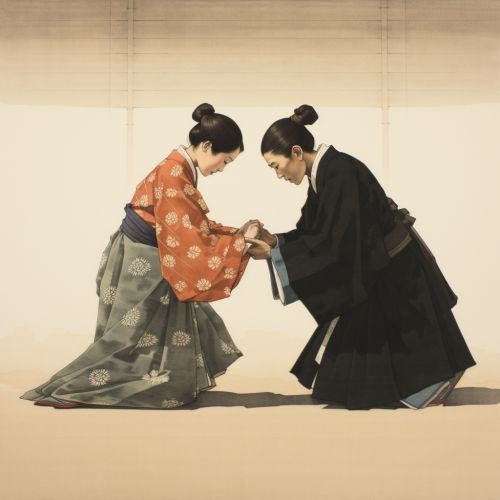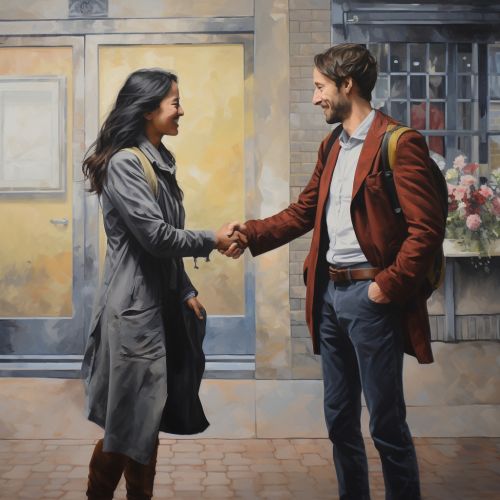Greeting
Introduction
Greeting is a basic form of communication that serves to acknowledge the presence of another individual. It is a universal phenomenon, found in every culture and society around the world. Greetings can take many forms, from a simple nod of the head to elaborate rituals involving speech, gestures, and body language. They are an essential part of social interaction, serving to establish and maintain relationships, express respect, and signal social status.


Etymology and Definition
The English word 'greeting' is derived from the Old English 'grētan', which means 'to come into contact with' or 'to meet'. In its most basic form, a greeting is an expression or action used to acknowledge the presence or arrival of another person. This can be verbal (such as saying 'hello'), non-verbal (such as waving or nodding), or a combination of both. Greetings are a fundamental aspect of human interaction, serving to initiate communication and establish social bonds.
Types of Greetings
Greetings can be broadly classified into two categories: formal and informal. Formal greetings are typically used in professional or official contexts, while informal greetings are used in casual or familiar settings.


Formal Greetings
Formal greetings are often characterized by a set protocol or etiquette. They may involve specific words, phrases, or titles, and may also include certain physical gestures such as handshakes, bows, or salutes. Formal greetings are commonly used in professional settings, during official ceremonies, or when addressing individuals of higher social status or rank.
Informal Greetings
Informal greetings are typically more relaxed and spontaneous. They can include a wide range of verbal expressions (such as 'hi', 'hey', or 'what's up') and non-verbal gestures (such as waving, hugging, or fist bumping). Informal greetings are commonly used among friends, family members, and peers.
Cultural Variations in Greetings
Greetings vary widely from culture to culture, reflecting different social norms, customs, and values. In some cultures, greetings involve physical contact such as handshakes, hugs, or kisses, while in others, they may involve bows, nods, or other non-contact gestures. Cultural differences in greetings can also extend to the words and phrases used, the appropriate level of eye contact, and the degree of formality or informality expected.


Asian Greetings
In many Asian cultures, greetings often involve bows rather than handshakes. The depth and duration of the bow can vary depending on the social status and age of the individuals involved. In Japan, for example, a deeper and longer bow indicates greater respect.
Western Greetings
In Western cultures, handshakes are a common form of greeting. The handshake is typically firm and brief, and is often accompanied by direct eye contact and a smile. In some Western cultures, particularly in Southern Europe, it is also common for close friends and family members to greet each other with a hug or a kiss on the cheek.
Middle Eastern Greetings
In Middle Eastern cultures, greetings are often characterized by a high degree of physical contact. It is common for individuals of the same gender to greet each other with a handshake followed by a hug or a kiss on the cheek. In contrast, greetings between individuals of different genders are often more reserved, reflecting cultural norms around modesty and gender segregation.
The Science of Greetings
From a scientific perspective, greetings can be seen as a form of nonverbal communication. They involve a complex interplay of verbal and non-verbal cues, including words, tone of voice, facial expressions, body language, and physical contact.


Psychology of Greetings
In psychology, greetings are seen as an important part of social interaction. They serve to establish and maintain social bonds, express respect and goodwill, and signal social status and power dynamics. Greetings can also convey a range of emotions, from warmth and friendliness to hostility and aggression.
Sociology of Greetings
From a sociological perspective, greetings are a form of social ritual that serves to reinforce social norms and values. They play a key role in regulating social interactions and maintaining social order. Greetings can also serve as a form of social control, enforcing conformity to expected behaviors and roles.
Anthropology of Greetings
In anthropology, greetings are seen as a cultural universal - a common feature found in all human societies. However, the specific forms and meanings of greetings can vary widely from culture to culture, reflecting different cultural norms, values, and social structures.
Conclusion
In conclusion, greetings are a fundamental part of human communication and social interaction. They serve a wide range of functions, from acknowledging the presence of another person to expressing respect and establishing social bonds. While the specific forms and meanings of greetings can vary widely from culture to culture, they all serve to facilitate social interaction and maintain social order.


